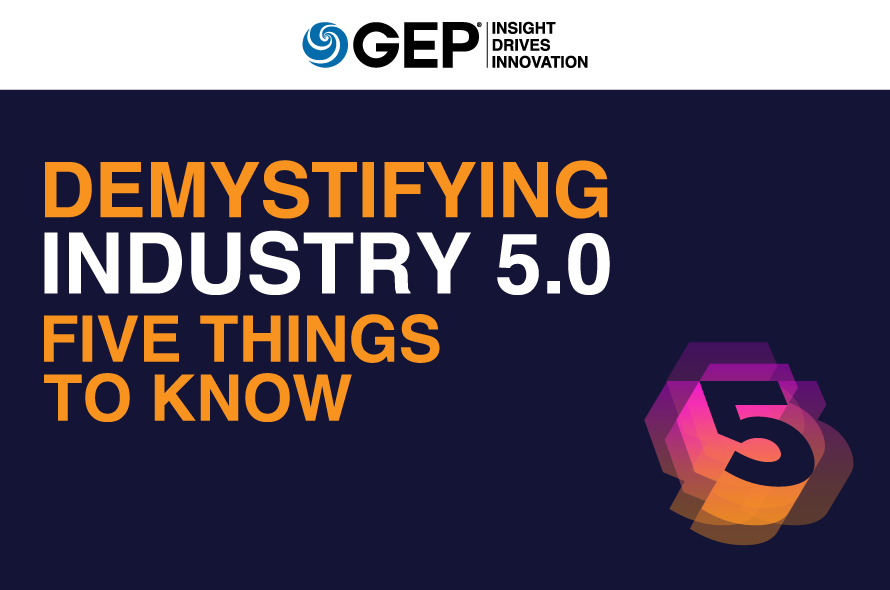Industry 5.0 was lauded as the coming of the cobots — agile robots designed to collaborate with humans. So why hasn’t this next phase of the industrial revolution caught fire?
A new GEP Bulletin — Demystifying Industry 5.0: Five Things to Know — details how manufacturers need to take incremental steps to achieve the full potential of the next wave of automation. This thought leadership piece shares the learnings of Tesla, Boeing, Apple and others as they navigate the new manufacturing era.
What’s Inside:
- Why Industry 5.0 stalled
- What’s the current state of automation?
- How manufacturers can course-correct
Just when industry practitioners thought they were beginning to understand how to realize the vision of Industry 4.0 in their specific industry, the term Industry 5.0 started gaining traction. Are we really on the cusp of another industrial revolution?
The concepts that Industry 5.0 encapsulates are largely already part of the original Industry 4.0 vision. Then why the new term, and why is it gaining traction? We believe that the popularity of this term is a signal that all is not well with Industry 4.0 in its current form and direction. We need to solve these issues to reap the full benefit of the revolution. It’s not important, meanwhile, whether we call it 4.0, 5.0 or anything in between.
What is Industry 4.0?
The Industrie 4.0 working group developed the original vision over 2009-2013 as a strategic initiative of the German government. The final report of the working group is a good reference, and the key elements and benefits it lays out are summarized below:
| Elements of the Original Vision | Potential Benefits |
|---|---|
|
|
What is Industry 5.0?
There are various definitions of Industry 5.0, but they largely cover three main aspects:
- Human-robot collaboration, giving rise to “cobots;”
- Mass customization using the human element; and
- Manufacturing that consciously manages its impact on society — workforce and environment.
The general claim is of an “augmentation age” where humans are back at the center of the factory, co-existing with and leveraging robots and other technology to achieve superior outputs and mass customization.
Industry 4.0 vs. Industry 5.0
The three most famous examples of Industry 4.0 early adopters are probably Tesla, Boeing and Apple. All three enterprises adopted the vision and tried to set fully autonomous manufacturing as a goal for themselves.
Over time, these enterprises realized that humans perform better than machines at anything outside the routine. These reversals came to be seen as a failure of Industry 4.0. The solution, in the form of cobots, came to be known as Industry 5.0. Cobots are robots that operate alongside humans and assist them, as opposed to traditional robots that operate in cages away from humans on the production lines.
Industry 5.0 arrived with much fanfare about “injecting the human back into the production line.”
However, if we review the final report referenced above, the vision it lays out already covers the three main aspects of Industry 5.0, at least at a high level. So Industry 5.0 is not a further step change. Also, because it has a narrower definition, it’s also not a holistic replacement for all of Industry 4.0.
We believe that the current perception and execution of Industry 4.0 has veered away from the original vision. This perception makes the vision less appealing and puts it at odds with societal well-being. This has tarnished the Industry 4.0 brand and led to calls for a new paradigm that focuses on the changes needed.
Enthusiastic marketers have coined this “Industry 5.0.” We believe that it’s more important to understand the current state of Industry 4.0 and the course corrections required than to create a new paradigm altogether.
Five Key Learnings From Industry 4.0 vs. Industry 5.0
Let’s look at each of the reasons in more detail, to understand what learnings we can draw from them and how we can course-correct.
#1: The original vision was very broad
The original vision referenced above is overarching and leaves a lot of room for narrower offshoots specific to industries and situations. It has a broad array of elements and benefits. This approach can leave practitioners with questions such as “Where do I start?” and “How do I apply this to my specific immediate situation?” which become hurdles to realizing benefits. The common reaction is to look for a narrower definition, such as the one for Industry 5.0 above.
Course-correction required:
Industry 4.0 is not a goal in itself, it is a vision. It involves creatively applying a bouquet of new technologies to solve the current problems your manufacturing operation is facing. For some industries, lights-out manufacturing may make sense (e.g., frozen foods, chemicals), while for others, mass customization will be more relevant (e.g., apparel, pharma). The key is to study it in the context of your industry and firm’s situation, to create a specific strategy that benefits you. The vision will provide guidance in getting to goals that were previously unreachable, using connected cyber-physical systems.
#2. Overcoming some hurdles has felt like a step change in itself
The original definition envisaged use of cyber-physical systems for collaboration. As practitioners began to implement it, the hurdle they quickly reached was of human-robot collaboration. Traditionally, robots have operated in cages, physically separated from humans — for a variety of reasons, including the safety of the humans. As the robot count increased, this became very difficult. One of Amazon’s patents explored putting humans in a protective enclosure — to help them operate safely in a robot-only zone — generated negative press for the company even though they clarified they never used that contraption.
Over time, a new breed of more agile robots — known as cobots — emerged, equipped with enough sensors and intelligence to work safely around human beings. Cobots seemed like a step change from the current state, leading marketing teams to try to slot them into Industry 5.0 instead of 4.0.
Course-correction required:
Industry 4.0 is going to be a long and arduous journey, with many milestones along the way that feel like step changes in themselves. There is no single end goal until we feel that we have maximized all potential gains from connected cyber-physical systems. For example, just wait for wide-spread 5G networks to be deployed — it will again feel like a step change.
#3. The hype around automation
The hype around Industry 4.0 focused on the automation aspect, and so fully autonomous lights-out manufacturing came to be seen as the end goal.
Course-correction required:
While these were all valid explorations on the journey of Industry 4.0, that journey never had full autonomy as a single-minded end goal. The vision is to deploy cyber-physical systems that result in new ways of creating value through new products or services. For example, a chocolate company may be able to cast your face in chocolate and deliver it to you next day at a reasonable cost. Another application: Digital twins may enable you to simulate an entire factory before laying the foundation and optimize for the most common scenarios.
#4. The business case has faltered in some industries
If we review the early implementations of Industry 4.0, most focused on reliability, optimized decision-making, and efficiency. The heavy capital investment required often did not correlate to the small or difficult-to-measure gain in these areas. As a result, the business case did not work out favorably.
The second wave of ideas revolved around flexibility — the ability to accommodate mass customization, unpredictable variables and rapid changes in demand fueled by social media trends, etc., and to maintain efficiency. To differentiate these new ideas from the original “let’s just get more efficient” concepts, they were classified as Industry 5.0.
Course-correction required:
Too often, the business case falters when Industry 4.0 is implemented because automation is seen as an end goal. The key is to understand that it is a means to solve an actual business problem.
Some products’ demand is becoming very volatile due to short-term social media trends. They will need Industry 4.0 to achieve unprecedented flexibility. For others, business is already booming and factories are cranking out products in three shifts. For them, Industry 4.0 will help enhance the reliability and predictability of production lines, eliminating production loss due to unscheduled downtime.
#5. Industry 4.0’s perception conflicts with “Society 5.0”
The perception is that Industry 4.0 will completely bypass workers in fully autonomous supply chains. This would put millions of workers out of the workforce and create a societal imbalance. Japan has ambitiously tried to recast and expand the vision into its “Society 5.0.” Again, while the original Industry 4.0 vision is fully compatible with Society 5.0, its current perception of completely bypassing workers is not.
Course-correction required:
The key here is to understand that Industry 4.0 must operate in society. It cannot have ripple effects that damage the societal fabric irreparably. The focus must be on using robots to offload dangerous or tedious tasks from humans, not to replace them altogether. Also, there must be a focus on upcycling and sustainability. Industry 4.0 must evolve to be in harmony with the natural as well as economic environment.
Conclusion
We believe that the elements Industry 5.0 focuses on, such as cobots and mass-customizations, were part of the original Industry 4.0 vision, and do not represent another step change. They have not been getting enough focus among practitioners, so the term Industry 5.0 puts the spotlight on them, which will help us course-correct. Whether we call it 4.0 or 5.0, what’s important is to heed the learnings from this dichotomy and respond effectively to reap the full benefits of the vision.
TURN IDEAS INTO ACTION. TALK TO GEP
GEP helps enterprise procurement and supply chain teams at hundreds of Fortune 500 and Global 2000 companies rapidly achieve more efficient, more effective operations, with greater reach, improved performance, and increased impact. To learn more about how we can help you, contact us today.

Pranav Padgaonkar
Senior Director, Consulting, GEP
Pranav is a Sr. Director in the Consulting Practice, and brings with him 17 years of extensive experience covering a broad spectrum of procurement and supply chain capabilities. He leads large consulting engagements focused on cost reduction, using digital transformation, strategic sourcing and supply chain optimization to deliver transformative results.

